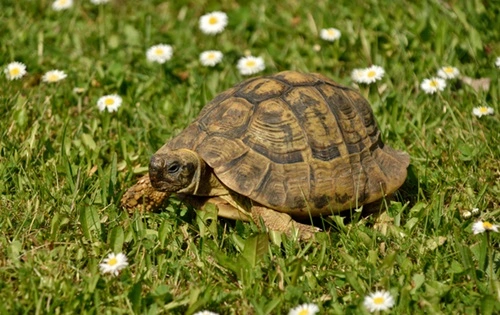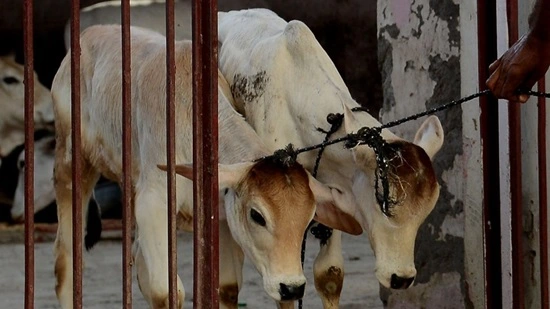India, a land of incredible biodiversity, is home to some of the most captivating butterflies in the world. These delicate winged wonders are not just a delight to the eyes but also vital indicators of a healthy ecosystem. Here, we explore the top 10 most common butterflies found in India, highlighting their unique features, habitats, and ecological importance.
1. Common Tiger
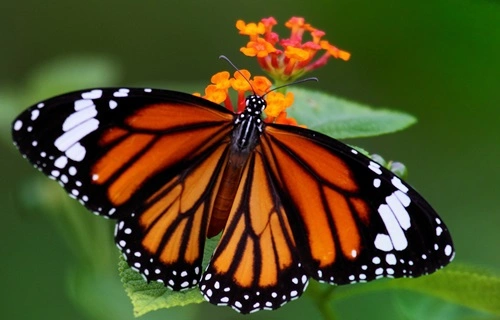
The Common Tiger butterfly is a striking species with bright orange wings marked by black and white patterns. Often mistaken for the Monarch butterfly, it is a frequent sight in gardens, parks, and open fields.
Key Features:
- Wingspan: 70-80 mm
- Color: Orange with black veins and white spots
- Habitat: Grasslands, forests, and urban gardens.
Importance:
- Pollinates a variety of flowering plants.
- Plays a key role in ecological chains as both predator and prey.
2. Common Jezebel
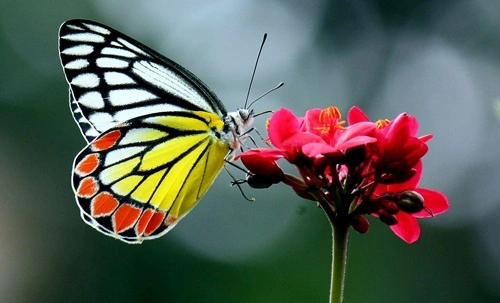
The Common Jezebel is a colorful butterfly known for its vibrant combination of yellow, white, and red hues. Its vivid colors serve as a warning to predators about its toxicity.
Key Features:
- Wingspan: 60-85 mm
- Color: White and yellow with crimson spots on the underside
- Habitat: Forests, gardens, and urban areas.
Importance:
- Helps in the pollination of native plants.
- An indicator of environmental health.
3. Lime Butterfly
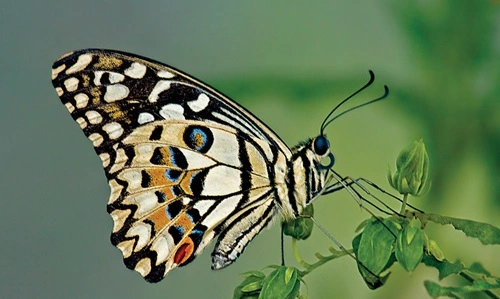
The Lime Butterfly is a fast-flying and common species found across India. Its caterpillars are known to feed on citrus plants, making it a familiar sight near orchards.
Key Features:
- Wingspan: 80-100 mm
- Color: Black with yellow and white markings
- Habitat: Gardens, agricultural fields, and urban areas.
Importance:
- Pollinator of citrus and other fruit plants.
- A pest species in orchards, balancing its ecological role.
4. Blue Mormon
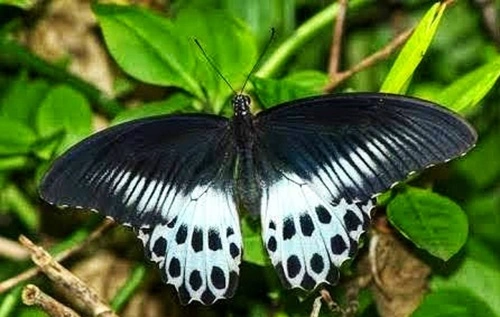
The Blue Mormon, Maharashtra’s state butterfly, is one of the largest butterflies in India. Its elegant flight and deep blue wings make it a spectacle in the wild.
Key Features:
- Wingspan: 120-150 mm
- Color: Black with iridescent blue patches
- Habitat: Evergreen forests and urban gardens.
Importance:
- A strong pollinator of flowering plants.
- Indicates the presence of rich biodiversity.
5. Peacock Pansy
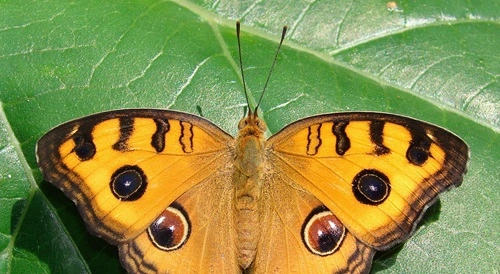
The Peacock Pansy is a medium-sized butterfly known for its eye-catching eye spots on the wings, which resemble peacock feathers.
Key Features:
- Wingspan: 50-65 mm
- Color: Orange with eye-like patterns on the wings
- Habitat: Open grasslands, roadsides, and parks.
Importance:
- Its unique patterns deter predators.
- Contributes to pollination in its habitat.
6. Plain Tiger
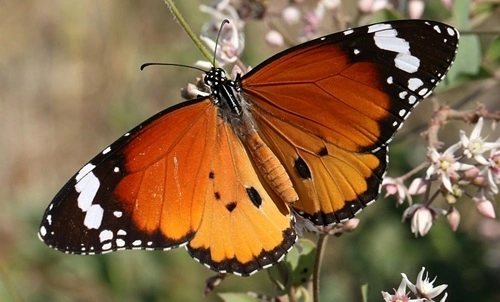
A close relative of the Common Tiger, the Plain Tiger is one of the most widespread butterflies in India. It is often seen basking in the sun or fluttering near flowers.
Key Features:
- Wingspan: 65-80 mm
- Color: Bright orange with black and white markings
- Habitat: Open fields, gardens, and scrublands.
Importance:
- Feeds on toxic plants, becoming distasteful to predators.
- Pollinates a variety of native and cultivated plants.
7. Common Crow
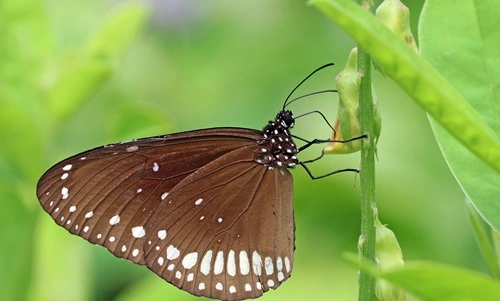
The Common Crow butterfly is a dark-hued beauty often found in urban areas. Despite its unassuming color, it has a graceful flight and a significant ecological role.
Key Features:
- Wingspan: 85-95 mm
- Color: Brownish-black with white spots
- Habitat: Urban gardens, forests, and open fields.
Importance:
- Pollinates a range of flowers.
- A model species in mimicry studies due to its distastefulness to predators.
8. Crimson Rose
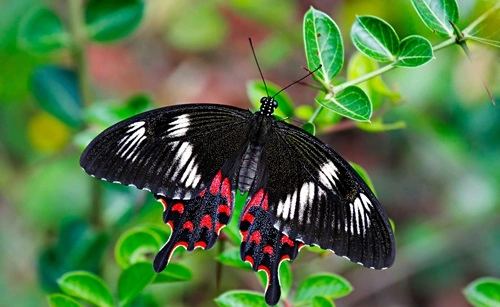
The Crimson Rose butterfly is a large, striking species with black wings and crimson spots. Its bright colors are a warning sign of its toxicity.
Key Features:
- Wingspan: 80-100 mm
- Color: Black with red spots and white streaks
- Habitat: Coastal areas, gardens, and forests.
Importance:
- Pollinator of rare coastal plants.
- Supports food chains in coastal ecosystems.
9. Striped Tiger
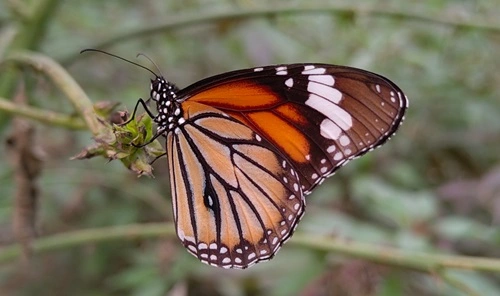
The Striped Tiger is a subspecies of the Common Tiger and is easily identifiable by its bold black stripes on orange wings. It is often seen flying lazily in open areas.
Key Features:
- Wingspan: 70-85 mm
- Color: Bright orange with black stripes and white spots
- Habitat: Meadows, scrublands, and urban spaces.
Importance:
- Plays a role in plant reproduction through pollination.
- Its caterpillars feed on toxic milkweed, deterring predators.
10. Tailed Jay
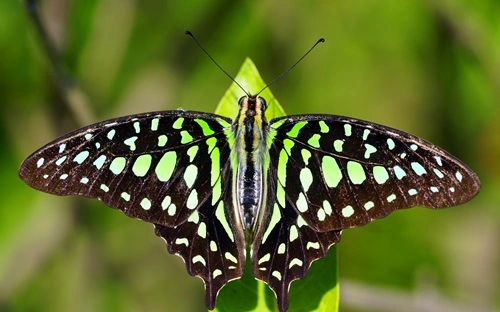
The Tailed Jay is a swift, vibrant butterfly often seen darting between flowers. Its green and black wings give it a unique appearance.
Key Features:
- Wingspan: 85-100 mm
- Color: Green with black spots and tailed hindwings
- Habitat: Rainforests, gardens, and plantations.
Importance:
- A highly efficient pollinator.
- Helps maintain floral biodiversity in its habitat.
Ecological Importance of Butterflies
Butterflies are crucial for maintaining ecological balance. Here’s why they matter:
- Pollination: Butterflies pollinate flowering plants, contributing to biodiversity and agricultural productivity.
- Food Chain: They serve as prey for birds, reptiles, and other animals, thus supporting food webs.
- Environmental Indicators: Their presence or absence reflects the health of an ecosystem, signaling changes in climate or habitat quality.
Conservation Efforts
Despite their abundance, butterflies face threats from habitat loss, pesticide use, and climate change. To protect these beautiful creatures:
- Plant native flowering plants to provide nectar and host plants for caterpillars.
- Avoid the use of chemical pesticides in gardens and agricultural fields.
- Promote awareness about the importance of butterflies in biodiversity.
Conclusion
Butterflies are a fascinating and essential part of India’s natural heritage. Their presence not only adds color to our landscapes but also sustains the delicate balance of our ecosystems. By understanding and protecting these winged marvels, we can ensure a thriving environment for generations to come.
